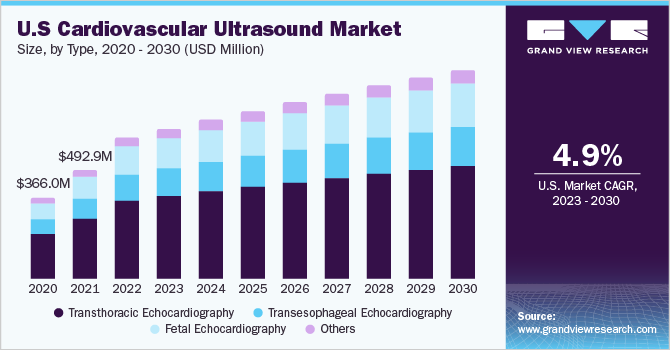Part
01
of one
Part
01
U.S. Echo-Cardiography Market: Trans-Thoracic Focus
Summary
This is an initial research sprint to get you the most important data first. Check out the Next Steps section for our plan of attack. As always, feel free to add comments or questions at the bottom.
An extensive search on the US echocardiography market size with a special focus on transthoracic echocardiography was conducted but the data was not found. However, we found information on the global transthoracic echocardiography market size, the US handheld echocardiography market size, and the global and North America's echocardiography market size. Below, we have provided some helpful findings from our research as well as the different research strategies employed.
Creative Solutions
- Information pertaining to the US echocardiography market size with a special focus on transthoracic echocardiography is not available in the public domain.
- Therefore, we provided helpful findings that detail the the global echocardiography and transthoracic echocardiography market size.
- Please refer to the Research Strategy for additional information surrounding the research process.
Global Transthoracic Echocardiography Market Size.
- In 2022, the global market for transthoracic echocardiography (TTE) was valued at approximately $998.8 million.
- Projections indicate that by 2032, the TTE market is anticipated to grow to $1.69 billion.
- The growth trajectory of the TTE market is largely attributed to the multifaceted applications of the technology.
- Within the global cardiovascular ultrasound sector, transthoracic echocardiography represented a 55% share of the total revenue.
US Handheld Echocardiography Market Size
- The U.S. market for handheld echocardiography devices was valued at $21.6 million in 2022 and is forecasted to rise from $23.9 million in 2023 to $52.6 million by 2030, with an expected compound annual growth rate (CAGR) of 11.9%.
- Transthoracic echocardiography holds a considerable portion of this market, driven by the widespread incidence of cardiac conditions that are diagnosable and manageable through transthoracic echocardiographic techniques.
- The primary users of these devices include diagnostic centers, ambulatory surgical centers, and hospitals. The expansion of hospital facilities in the U.S. and the escalating need for rapid diagnostic procedures have spurred the adoption of handheld echocardiography devices.
Global and North American Echocardiography Market Size
- The global market for echocardiography was valued at $1.59 billion in 2021 and is anticipated to increase from $1.71 billion in 2022 to $2.83 billion by 2029, growing at a compound annual growth rate (CAGR) of 7.5%.
- The market declined by 8.3% in 2019.
- In 2021, North America held the preeminent market share with a market size of $410 million, which can be ascribed to the rising incidence of peripheral and coronary heart diseases.
- The proliferation of the echocardiography market is linked to the surge in heart-related disorders, with the CDC reporting around 802,000 heart attack incidents in the U.S. annually, of which 605,000 are first-time occurrences.
- Additionally, the increased demand for non-invasive medical procedures and the diagnostic efficacy of echocardiography are significant factors propelling market growth.
- Prominent market leaders within the U.S. echocardiography sector include General Electric and Boston Scientific Corporation.
Research Strategy
The research team has utilized the most advanced research methodologies, such as generative AI-powered search, industry and research databases, and advanced web search techniques to facilitate our research. We leveraged the most reputable sources of information that were available in the public domain, including Globe Newswire, Global Market Insights, and Fortune Business Insights. After an extensive search, we found that information on the US market size for echocardiography with a specific focus on transthoracic echocardiography was not available in the public domain. Furthermore, a breakdown of procedures reimbursed under the relevant codes in the last fews years and the projected growth was not publicly available.
To find the US market size of echocardiography and transthoracic echocardiography, we first attempted to look through media and industry-specific databases and reports, such as Fact.MR, Future Market Insights, and Strategic Market Research. However, these sources focused on the global market size of echocardiography with very limited mentions of the market size in the United States. We then attempted to find the data from annual reports and publications by publicly traded companies that manufacture transthoracic echocardiography equipment such as General Electric, Boston Scientific Corporation, and Philips but did not find the needed information . As a last resort, we attempted triangulation to find the market size. We tried to find useful data such as the market share for echocardiography and transthoracic echocardiography in the US but to no avail. For this reason, we concluded that the information is not available in the public domain and expanded our scope to global.
To find a breakdown of procedures reimbursed under the relevant codes, we checked multiple healthcare databases, including Health Data, Data.Gov, and Healthcare.Gov but found nothing relevant. We then attempted to review insurance policy documentation from sites such as CMS, Intersocietal Accreditation Commission, and Cardiovascular Business but the sources did not provided the requested information. Finally, we attempted to search through academic institutions such as the American College of Radiology, Harvard, and University of California but these sites focused on reimbursement rates. Therefore, we concluded that the information is not publicly available.
Next Steps
In the first three hours of research, we provided insights on the echocardiography market. We propose continuing with the research to provide a comparative analysis of reimbursement rates for similar procedures in the cardiac ultrasound space, recent and anticipated changes to reimbursement policies that could impact the echocardiography business landscape, the impact of telehealth or remote diagnostic advancements on reimbursement regulations and procedures, and insights on the reimbursement and growth of routine follow-ups in the cardiac sector.
